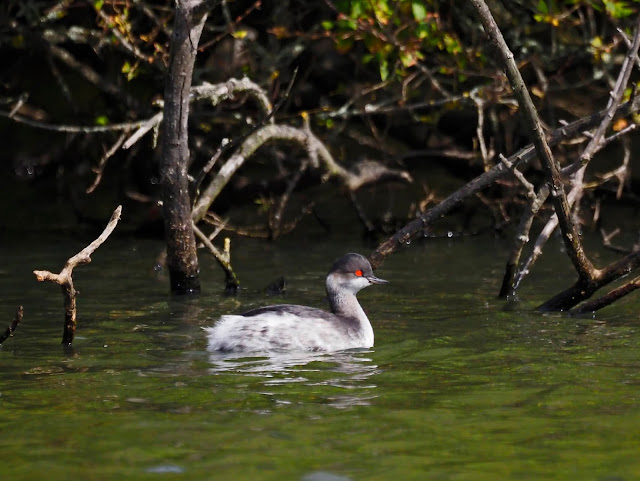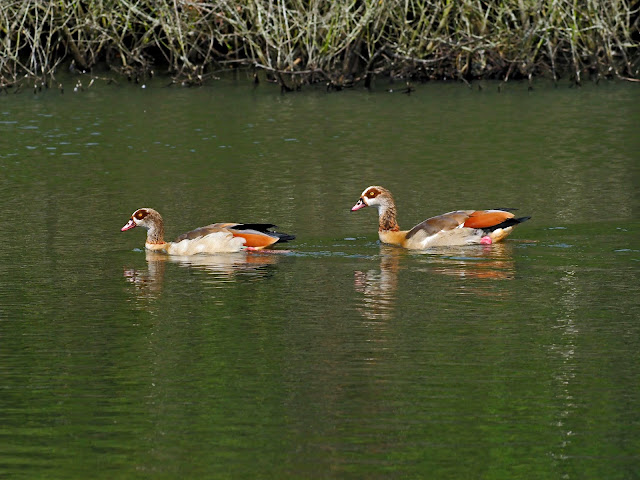I booked a rental car (my free bonus 3 day weekend rental under Europcar’s loyalty scheme!) from 18th September 2021 to 21st September 2021 for a trip away from home and visits to a number of sites.
My trip provided
excellent birding opportunities, including 6 further additions to my UK year
list for 2021 taking it to 165 species to date (Pectoral Sandpiper, Black-necked
Grebe, Arctic Skua, Red-throated Diver, Common Scoter
and Knot).
18th September 2021
I visited Alexandra Lake in Wanstead in east London to see a Black-necked
Grebe that has been present since at least early May 2021.
This a species that is only rarely seen during the summer months and even
less frequently as a breeding species (although notably this year at RSPB Bowers Marsh in Pitsea close to where I
live). I normally record Black-necked Grebe each year off the coast of
East Anglia and sometimes on some of the larger reservoirs.
I had been intending to visit Alexandra Lake
for some time which I could have easily reached by public transport and maybe I
should have done so to see and photograph this Black-necked Grebe in its
spectacular summer plumage (see here) rather than its autumn/winter plumage.
The last few miles to and away from
Alexandra Lake were very slow with stop-start crawling traffic but the
frustration was relieved a little by the remarkable sighting of a Common Buzzard
over the A13/A406 intersection. This bird seems to be everywhere now.
Alexandra Lake is contained within the
wider Wanstead Flats area surrounded by the heavily
built-up areas of Leytonstone to the west, Wanstead to the north with Manor Park and Forest Gate to the
south east and south respectively. To the north west it is connected by way of
Bush Wood to Leyton Flats and to more northerly reaches of Epping Forest.
It is a typical urban lake surrounded by open
countryside and some woodland and I would not have considered visiting it had
it not been for the long-staying Black-necked Grebe which I still had to
add to my UK year list for 2021.
I had to complete at least half of the circuit of
the lake before I finally spotted the Black-necked Grebe regularly
diving for food. However, it also spent much of the time either partially
hidden or completely out of view in the vegetation at the edge of a large
island.
Fortunately, the Black-necked Grebe did
provide some photo opportunities and the results are definitely my best for
this species which is not surprising since most views that I have are very distant
telescope views on the coast. Whilst the red eye was still very notable, the
bird has moulted out of its summer plumage into its blacker/greyer
autumn/winter plumage.
Photo: Black-necked Grebe at Alexandra Lake, Wanstead
Photo: Black-necked Grebe at Alexandra Lake, Wanstead
Photo: Black-necked Grebe at Alexandra Lake, Wanstead
Photo: Black-necked Grebe at Alexandra Lake, Wanstead
Other birds recorded
were all relatively common species, most notably Gadwall (5), Common
Pochard (1) and Little Grebe (4) but also Mallard, Mute Swan,
Egyptian Goose, Canada Goose, Greylag Goose, Coot, Moorhen
and Black-headed, Herring and Lesser Black-backed Gulls.
Photo: Greylag Goose at Alexandra Lake, Wanstead
19th September 2021
Frustratingly, given the
excellent sightings recorded throughout the year, RSPB Bowers Marsh in Pitsea in south Essex is difficult to
reach by public transport (a very long walk from the nearest bus stop to the
reserve entrance even before a long walk around the reserve itself). Therefore,
I took advantage of having a car to visit this site.
Although I failed to see the breeding pair
of Black-necked Grebes and their now well-grown juveniles, this proved
to be very successful visit, most of which I spent with another birder who it
turned out lives only a few streets away from me.
The main highlights from my visit were: Little
Stint (2), Black-tailed Godwit (c.100), Avocet (1), Common
Snipe (1), Lapwing (c.10), Little Egret (1), Wigeon (a
very large flock of at least 500 evidently arrived for the winter), Pintail
(2), Mallard (c.15), Shoveler (2), Little Grebe (1), Mute
Swan (6), Canada Goose (c.20), Greylag Goose (several large
and noisy flocks flighting in from the north), Coot, Moorhen, Peregrine
(1 juvenile), Kestrel (1), Bearded Tit (several heard calling), Cetti’s
Warbler (heard singing), Reed Warbler (2), Chiffchaff (1), Yellow
Wagtail (1), Reed Bunting (2)
After returning home at lunchtime to watch
West Ham United v. Manchester United from 2 p.m., I drove up to Norwich after
the match for my overnight stay at Premier Inn Norwich West.
20th September 2021
I spent around 2 hours from 7:30 a.m. at NWT Cley and Salthouse Marshes on the north Norfolk coast although I focused on Arnold’s
Marsh at the eastern end of the reserve for waders (specifically Curlew
Sandpiper which had been reported there and which I had yet to record for
my UK 2021 year list) and on the sea for skuas, divers, sea ducks, etc.
Arnold’s Marsh proved to be very productive
(except for the absence of any record of Curlew Sandpiper which seems to
be very scarce this autumn) and I recorded the following: Little Stint
(2), Ruff (2), Knot (1), Dunlin (c.100), Spotted
Redshank (2), Common Redshank (c.100), Black-tailed Godwit
(c.50), Curlew (c.20), Avocet (30), Lapwing (c.20), Wigeon
(c.100), Mallard (c.10), Teal (c.10), Shelduck (15), Mute
Swan (2), Sandwich Tern (4), Common Gull (1), Cormorant (c.15),
Little Grebe (3), Little Egret (4), Grey Heron (2), Marsh
Harrier (1), Common Buzzard (1), Kestrel (1), Bearded Tit
(several heard calling), Swallow (1)
Regular scanning of the sea with both my
binoculars and telescope produced 3 expected additions to my UK 2021 year list:
Arctic Skua (1), Red-throated Diver (1) and Common Scoter
(c.30). In addition, I recorded Gannet (at least 45, a mix of small groups
of adults and immatures flying both west and east), Kittiwake (1), Guillemot
(1), Sandwich Tern (c.30 either as singles or in small groups), Cormorant
(10), Brent Goose (first returning birds of the winter in groups of
2, 8 and 2), Grey Plover (1 landed briefly on the beach)
After spending some time for quiet reflection and commemoration of my Mum’s death (the third anniversary) at Cromer cliffs where her ashes are scattered, I drove home via EWT Abberton Reservoir in Essex where I successfully found the Pectoral Sandpiper in Wigborough Bay. Unfortunately, the view was a very distant one through my telescope and the prospect of even a record photo was impossible. This Nearctic wader is reported annually in the UK in autumn and I have previously recorded it on 11 occasions since 1990, including at EWT Abberton Reservoir in October 2010 and August 2017.











No comments:
Post a Comment
If you feel like commenting on my blog, you can contact me by completing the comment form below. I will respond to all comments and enquiries and constructive criticism will always be welcomed.